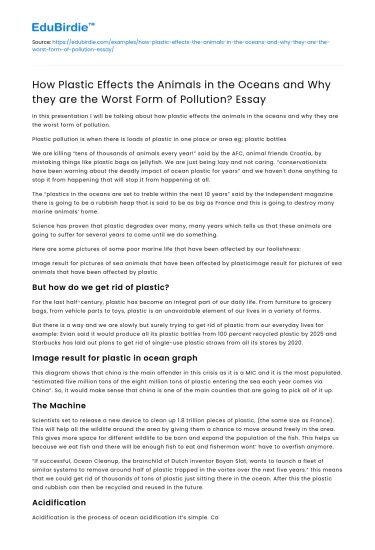Table of contents
- Introduction
- Impact on Marine Biodiversity
- Systemic Challenges of Plastic Pollution
- Global Response and Future Directions
- Conclusion
Introduction
The proliferation of plastic in the world's oceans has emerged as one of the most pressing environmental issues of our time. Ocean animals, from the smallest plankton to the largest whales, are adversely affected by plastic pollution, which has been deemed the worst form of pollution due to its pervasive and enduring impacts. Plastic debris is found in the remotest parts of the oceans, carried by currents and contributing to the formation of vast garbage patches. According to the United Nations, approximately 8 million tons of plastic end up in the oceans each year, posing lethal risks to marine biodiversity (UN Environment Programme, 2018). The persistence of plastic, which can take hundreds of years to decompose, exacerbates its environmental impact. This essay explores the detrimental effects of plastic pollution on ocean animals, examines the underlying causes of this pollution, and evaluates the global response to this growing crisis.
Impact on Marine Biodiversity
Plastic pollution poses a multifaceted threat to marine biodiversity, manifesting through physical, chemical, and biological harm. Physically, marine animals often mistake plastic debris for food, leading to ingestion that can cause internal injuries, starvation, and death. A study by the Commonwealth Scientific and Industrial Research Organisation (CSIRO) found that 90% of seabirds have ingested plastic at some point in their lives (Wilcox et al., 2015). Chemical contamination occurs as plastics leach toxic substances, such as bisphenol A (BPA) and phthalates, which can disrupt endocrine systems in marine organisms. Furthermore, plastics serve as vectors for invasive species and pathogens, altering ecosystems and threatening native species. For example, the invasive marine alga, Caulerpa taxifolia, has been found to hitchhike on plastic debris, spreading beyond its native range and damaging local habitats (Gregory, 2009). These impacts illustrate the complex and far-reaching consequences of plastic pollution on marine life.
Transitioning from the impact on individual species, it is essential to consider the broader ecological ramifications. Marine ecosystems are intricately connected, with the health of one species often influencing the entire food web. The introduction of plastic into these systems disrupts these connections, leading to cascading effects that can compromise ecosystem stability. As we delve into the systemic challenges posed by plastic pollution, it becomes clear that addressing this issue is not only about protecting individual species but also about preserving the integrity of marine ecosystems as a whole.
Systemic Challenges of Plastic Pollution
The systemic challenges posed by plastic pollution are rooted in both environmental and socioeconomic factors. Environmentally, the durability of plastic, once considered an asset, has become a liability. Plastics do not biodegrade but instead fragment into microplastics, which are easily ingested by marine organisms and have been found in the tissues of fish, mollusks, and even plankton. This infiltration of plastic into the food chain raises concerns about bioaccumulation and biomagnification, where toxic substances can concentrate in predators at the top of the food web, including humans (Rochman et al., 2013). Socioeconomically, the reliance on plastic products reflects consumer behaviors and industrial practices that prioritize convenience over sustainability. Efforts to regulate plastic production and waste management are often hampered by a lack of infrastructure, particularly in developing countries, where economic constraints limit the implementation of effective waste management systems.
In addressing these systemic challenges, it is important to consider counter-arguments that suggest alternative perspectives. Some argue that technological innovations, such as biodegradable plastics, offer a viable solution. However, the effectiveness of these alternatives is often limited by environmental conditions that affect degradation rates. Moreover, the production of biodegradable plastics still relies on finite resources and can contribute to pollution if not properly managed. As the debate continues, it is clear that a multifaceted approach is required, involving both technological advancements and changes in consumer behavior and policy.
Global Response and Future Directions
The global response to plastic pollution has been characterized by a mix of initiatives, ranging from international agreements to grassroots movements. The United Nations' Clean Seas campaign, launched in 2017, has mobilized governments, businesses, and individuals to reduce marine litter and promote sustainable alternatives. Many countries have implemented bans on single-use plastics, with the European Union's directive to phase out such products by 2021 being a notable example. However, the effectiveness of these measures is contingent upon enforcement and public compliance, which can vary significantly across regions.
Despite these efforts, the scale of plastic pollution necessitates a more comprehensive and coordinated response. The transition to a circular economy, where waste is minimized and materials are reused, represents a paradigm shift that could substantially reduce plastic pollution. Additionally, increased investment in research and development of sustainable materials and recycling technologies is critical. As individuals, consumers can contribute by adopting more sustainable practices, such as reducing plastic consumption and supporting companies committed to environmental stewardship.
Conclusion
In conclusion, plastic pollution in the oceans is a dire threat to marine life, with impacts that extend beyond individual species to disrupt entire ecosystems. The persistence of plastic in the environment, combined with its ability to transport toxins and invasive species, underscores the urgent need for action. While there are promising signs of progress, such as international agreements and innovations in sustainable materials, a holistic approach that addresses the root causes of plastic pollution is essential. This involves not only technological solutions but also shifts in consumer behavior and policy. By embracing a more sustainable relationship with plastic, society can mitigate the impacts of this pervasive pollution and safeguard the health of our oceans for future generations.






 Stuck on your essay?
Stuck on your essay?

